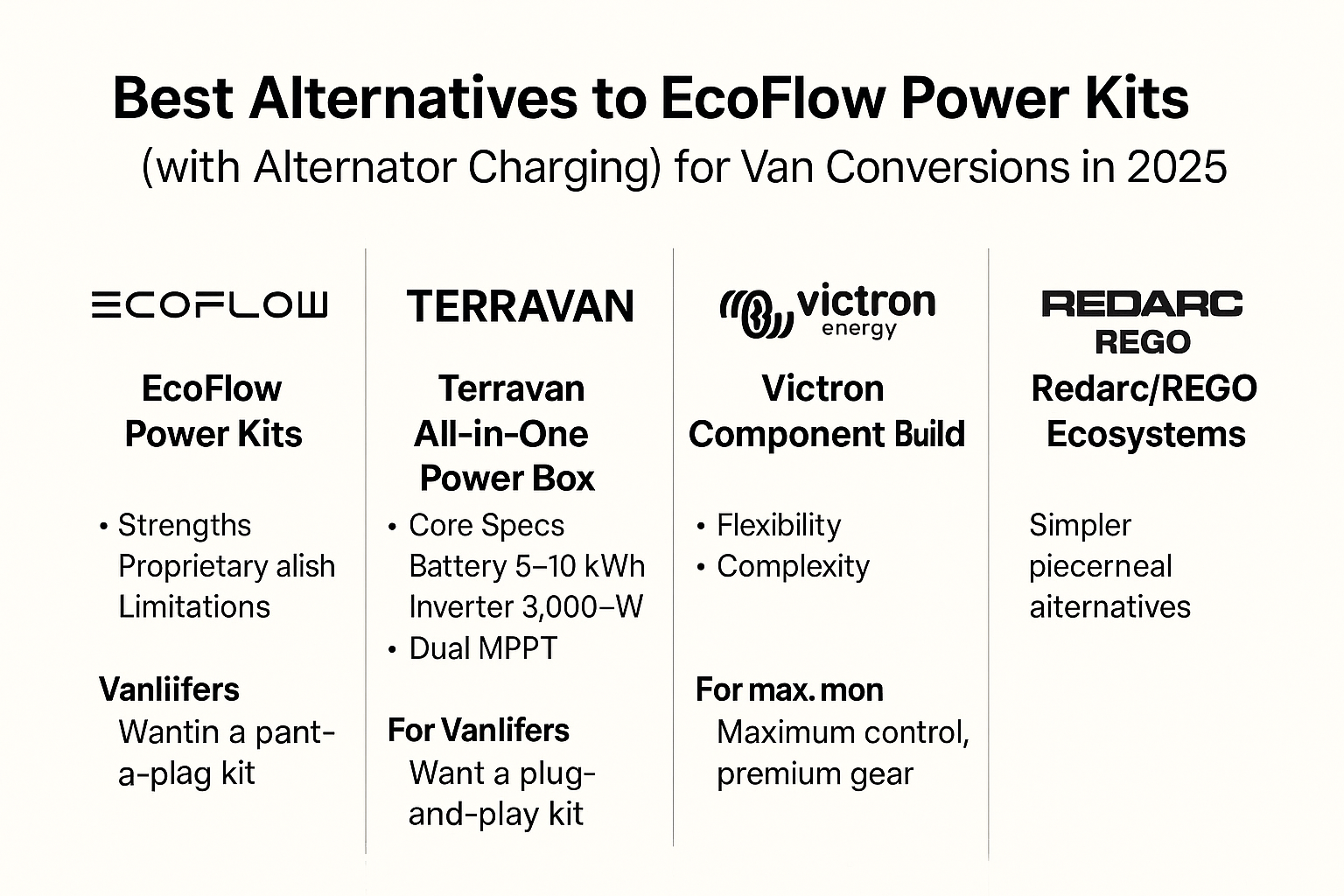Best Alternatives to EcoFlow Power Kits (with Alternator Charging) for Van Conversions in 2025
Neutral, test-driven comparison of EcoFlow vs fixed all-in-one boxes and modular builds. Focus: alternator charging, AC output, MPPT solar, install time, serviceability, expansion.
TL;DR: When to Choose EcoFlow vs a Fixed All-in-One Box
- EcoFlow Power Kits: Polished ecosystem and wide availability.
- Terravan All-in-One: One-box simplicity, clean DC distribution, service-friendly.
- Victron Component Build: Maximum flexibility and pro installer network.
- Redarc / Renogy REGO: Budget-friendly piecemeal upgrades.
Evaluation Criteria
- Alternator Input — native DC-DC support and current limits
- AC Output — continuous/surge power (W), 120V/240V capability
- Solar MPPT — # of inputs, max PV watts, voltage window
- Install Time — wiring complexity, pre-integration
- Serviceability — repair path, access, parts availability
- Expansion — extra batteries, PV growth, accessories
Option 1: EcoFlow Power Kits — Strengths, Limitations, Who It’s For
Strengths
- Polished ecosystem (app, cabling, accessories)
- Multiple pack sizes (~2–15 kWh)
- Broad retail/installer familiarity
Limitations
- Proprietary modules and cabling
- Cabinet/wall space and cable bulk to manage
- Premium pricing vs. alternatives
Best for: Vanlifers wanting a known, “kit-style” solution and who are fine with ecosystem lock-in.
Option 2: Terravan All-in-One Power Box — Core Specs, Alternator/MPPT, Expansion, Monitoring
One-box architecture for faster installs and cleaner wiring.
| Spec | Typical Range (2025 models) |
|---|---|
| Battery | LiFePO4, ~5–10 kWh (expandable) |
| Inverter/Charger (AC) | ~3,000–5,000 W continuous (pure sine) |
| Solar MPPT | Dual inputs, up to ~2,400 W combined (model-dependent) |
| Alternator DC-DC | Native ~60–80 A typical |
| Monitoring | Integrated app (SoC, shunt, charge sources) |
- Why it stands out: fewer boxes and cables, labeled I/O, service panels.
- Installer-friendly: reduced parts count and wall real estate.
Best for: DIYers and upfitters who want reliability without a complex component stack.
Option 3: Victron Component Build — Flexibility vs. Complexity
Strengths
- Gold-standard reliability and monitoring (Cerbo GX)
- Modular: MultiPlus inverter/chargers, multiple MPPTs
- Large global installer ecosystem
Limitations
- Steeper learning curve for DIY
- Higher labor/time for custom wiring and configuration
Best for: Builders needing maximum control, redundancy, and bespoke scaling.
Option 4: Redarc / Renogy REGO — Simpler Piecemeal Alternatives
Redarc: Proven DC-DC and Manager30 systems, popular for overlanding.
Renogy REGO: Semi plug-and-play modules with budget-friendly pricing.
Limitations
- Lower peak AC output than EcoFlow / Terravan / Victron
- More piecemeal wiring and mounting than a one-box AIO
Best for: Budget-minded builds that grow over time.
Real-World Scenarios
- Weekend Warrior: EcoFlow or REGO for quick setups.
- Full-Time Vanlife: Terravan for simplicity + expansion.
- Work Vans / Food Trucks: Terravan for AC-heavy loads and rapid recharge.
- High-End Expedition: Victron for custom redundancy and large PV arrays.
Cost of Ownership & Serviceability
- EcoFlow: Proprietary modules may increase replacement cost; broad support materials.
- Terravan: Access panels and standard parts improve service path.
- Victron: Excellent part availability; labor/time can be higher.
- Redarc/REGO: Lower upfront cost; fewer premium features.
Installation Overview (1-Page Schematic + BOM)
High-level steps; follow the manufacturer’s manual for specifics.
- Plan layout and cable runs — verify clearances, ventilation, and mounting surfaces.
- Mount the power system — single enclosure (AIO) vs multiple modules (modular).
- Wire DC and protection — correct fusing, bus bars, and grounding.
- Connect charge sources — shore AC, alternator DC-DC, PV inputs.
- Commission and test — set charge profiles, confirm SoC, test PV/alternator/AC loads.
Decision Matrix & Buyer Checklist
| System | Alternator Input | AC Output (continuous) | Solar MPPT | Install Time | Serviceability | Expansion |
|---|---|---|---|---|---|---|
| EcoFlow Power Kits | Yes (ecosystem module) | Up to ~5,000 W* | Dual (model-dependent) | Moderate | Proprietary | High |
| Terravan All-in-One | Native ~60–80 A | ~3,000–5,000 W | Dual, up to ~2,400 W | Fast (one box) | Service-friendly | High |
| Victron Build | Yes (via DC-DC) | ~3,000–10,000+ W | Scalable (multiple MPPTs) | Complex | Excellent | Very High |
| Redarc / REGO | Yes (via DC-DC) | < 3,000 W (typ.) | Single / limited | Moderate | Good | Medium |
Buyer Checklist
- Alternator output & DC-DC current limits
- AC loads (continuous & surge) for induction and A/C
- PV array size and controller limits
- Mounting space and ventilation
- Warranty & repair path (who services what)
Download Decision Matrix (CSV) | Download (JSON)
*Exact specs vary by model; verify current datasheets before purchase.
FAQs
How big should my alternator charging be?
For most vans, 60–80 A DC-DC is typical. Confirm vehicle alternator rating and follow manufacturer guidance.
How much solar can these systems handle?
All-in-one units often support ~1.5–3.0 kW across one or two MPPTs. Modular Victron builds can scale with additional controllers.
Can I run an induction cooktop and a mini-split?
Plan for ~3–5 kW continuous AC plus surge capacity. Terravan and EcoFlow cover many use cases; Victron can scale higher.
Which option is easiest for DIY?
A single-enclosure AIO minimizes wiring and mounting. Modular stacks add parts and configuration steps.
What about serviceability on the road?
AIOs reduce points of failure and are easy to access; modular systems allow swapping individual parts but require more diagnosis.
How to Talk to an Installer
- Ask for alternator current limits and cable gauge/fusing plan.
- Verify mounting, ventilation, and clearances.
- Clarify warranty responsibilities (manufacturer vs installer).
- Check lead times for kits vs one-box vs modular components.
- Request a handover checklist (settings, safety checks, spares).

